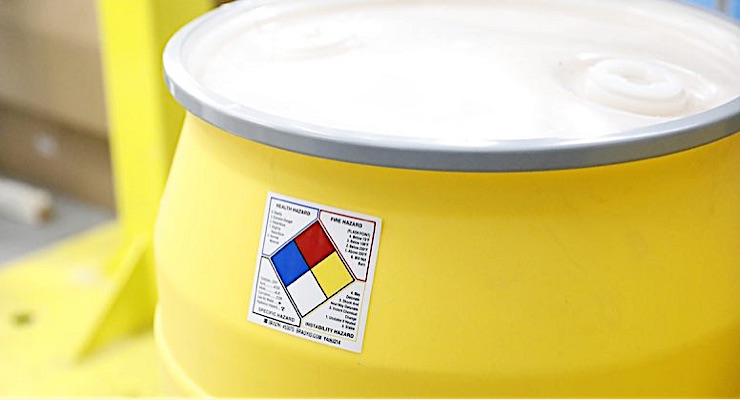
But with both national and international organizations requiring different standards for chemicals, along with various labeling requirements for differing chemicals and hazardous materials, there is a lot of information to consider.
In this article, we’ll take a look at what durable labels are and the industry standards, regulations, and requirements each organization must comply with to keep those individuals shipping, transporting and handling dangerous goods safely.
A durable label, sometimes called a drum label, is a thermal label applied to containers, like drums, canisters, or barrels, holding potentially or known hazardous chemicals, materials and waste. These labels must be made with extremely substantial materials and a strong adhesive to guarantee they do not fall off, become damaged, scratched, or faded.
The materials used for durable labels are non-paper, synthetic materials, usually polypropylene, polyester, or polyethylene, a blend of the previous two. These types of materials are tear, weather, and scratch-resistant, as well as resistant to oils and chemicals. Other sturdy materials like vinyl and nylon can also be used. These synthetic materials are more expensive than paper products but the benefits outway the costs when it comes to durability.
The organizations that require these labels do so with the mission to identify and classify hazardous products, to educate and inform workers, employees, and emergency personnel, and overall create a safe environment that prevents injury, illness, or fatality.
In order to communicate the many potential dangers each product is comprised of, durable labels generally consist of two common elements:
- Colors
- Pictograms or symbols
OSHA (Occupational Safety & Health Administration) is a US organization created in 1970 to ensure safe working conditions by enforcing set standards, training, and education. It is regulated by the United States Department of Labor with the mission of protecting workers under the belief that a safe workspace is a basic human right.
Employers are required to notify employees about the dangers of hazardous chemicals through several methods, such as information sheets, color-coded systems, and labels.
OSHA Label Requirements
As of 2015, OSHA updated their requirements for labeling hazardous chemicals under its Hazard Communication Standard (HCS). The labeling requirements are designed to improve awareness and knowledge of the hazards associated with the chemicals present in their workplace.
Durable labels leaving the workplace that contain hazardous chemicals are required to have:
- Pictograms
- Hazard & precautionary statements
- A single word
- Product identifier
- Supplier identification
WHMIS
The WHMIS (Workplace Hazardous Materials Information System) is Canada’s national hazard communication system. It was implemented in 1988 with the intention of providing comprehensive information on hazardous materials in the workplace and communicating health and safety information for hazardous products being used, handled, or stored.
WHMIS has since added updates to incorporate the GHS, or Global Harmonized System, which is an international approach to classifying and communicating hazardous information through labels. In 2015, it also made revisions to the Hazardous Products Regulation (HPR), which introduced new compliance requirements for employers, importers, suppliers, and distributors.
Suppliers are responsible for labeling any hazardous products they are providing to customers while employers are responsible for preparing and applying labels to hazardous materials entering the workplace.
WHMIS Label Requirements
In order to alert workers and employees to a dangerous product and keep them informed of basic safety precautions, WHMIS durable labels must be placed on all containers housing hazardous materials.
There are three types of WHMIS durable labels, each one with different requirements depending on the container type:
- Supplier Label: Supplier labels are applied to the container by the manufacturer. Instructions must be written in both official Canadian languages, English and French.
- Workplace Label: Workplace labels are necessary if the supplier label is damaged or missing, the hazardous contents of a container have been transferred from the supplier container to another one, or the materials have been produced for use in the workplace or for export. These labels are meant to be produced by the employer or employee in the workplace. They require less information than supplier labels because it assumes employees in the workplace are familiar with the chemicals being handled.
- Laboratory Label: Laboratory labels are utilized when lab supplies are transferred from one container to another, new compounds are made in a laboratory, or laboratory samples need to be identified.
March 30, 2021 at 09:41PM
https://ift.tt/3rGNeqR
Examining Durable Label Standards - Label and Narrow Web - Label & Narrow Web Magazine
https://ift.tt/3fbzbE8
Bagikan Berita Ini

















0 Response to "Examining Durable Label Standards - Label and Narrow Web - Label & Narrow Web Magazine"
Post a Comment